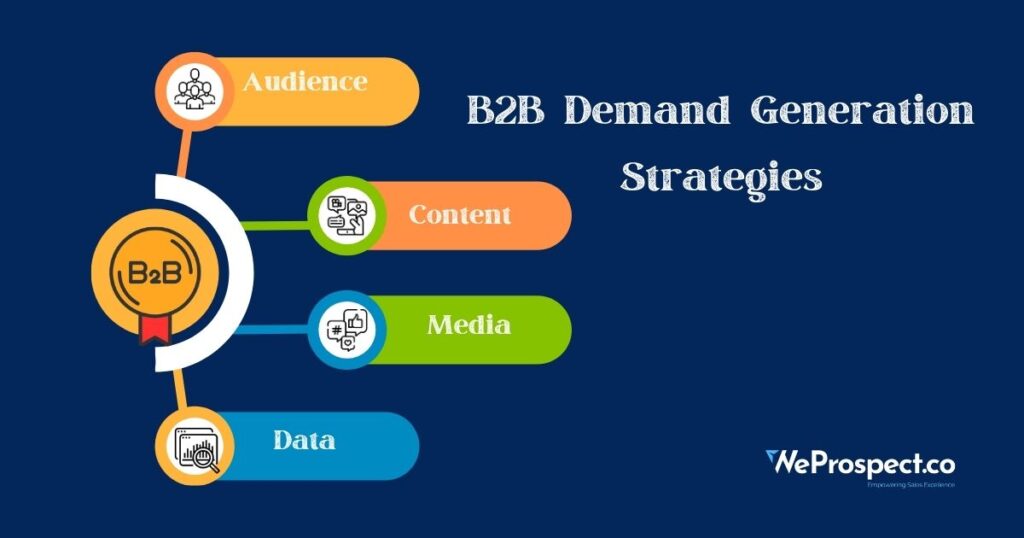
Improving your B2B Demand Generation Strategies is vital for attracting new prospects and turning them into loyal customers. With the right approach, you can create a consistent pipeline of high-quality leads that are more likely to convert. To achieve this, consider focusing on several key areas to help optimize your demand generation efforts. At WeProspect.co, we understand the importance of a tailored strategy that aligns with your business goals and target audience.

Understanding your target audience is the foundation of any successful B2B demand generation strategy. You need to identify your ideal customer profile (ICP), which represents the type of customer most likely to benefit from your products or services. Start by researching and creating detailed buyer personas that outline the needs, pain points, preferences, and decision-making processes of your target customers. This understanding enables you to craft content and messaging that resonates more effectively, addressing the unique challenges your audience faces.
Content is one of the most powerful tools in any B2B demand generation strategy. To attract and engage potential customers, produce a variety of high-quality content types, such as blogs, whitepapers, case studies, eBooks, webinars, and podcasts. Your content should offer value by addressing your audience’s problems and providing solutions. Additionally, align your content with the different stages of the buyer’s journey to nurture prospects at every step. For instance, educational content like blog posts and webinars can help raise awareness, while case studies and eBooks can support the consideration stage. Make sure to optimize all content with SEO best practices to increase visibility and drive organic traffic to your website.
Paid media and account-based marketing (ABM) are also effective tactics for a B2B demand generation strategy. Paid media, including Google Ads and social media advertising, can quickly extend your reach and visibility among your target audience. With targeted ads, you can attract more qualified leads by presenting tailored messages to specific segments of your audience. ABM, on the other hand, focuses on creating personalized marketing campaigns for high-value accounts. By aligning your marketing and sales teams to work together on these key accounts, you can boost engagement and conversion rates. ABM allows you to deliver highly customized experiences to your most important prospects, increasing the likelihood of conversion.
Lead nurturing is essential for keeping prospects engaged over time. A successful B2B demand generation strategy should incorporate various lead nurturing tactics, such as email marketing, retargeting, and drip campaigns. These tactics help maintain a consistent line of communication with your prospects, delivering valuable content and offers based on their behavior and interests. Personalized email marketing, in particular, can significantly enhance engagement and conversion rates. For example, you can send tailored emails to prospects based on their interactions with your website or content, ensuring that your messages are relevant to their specific needs and challenges. This approach helps build trust and establishes your brand as a reliable partner.
A strong presence on social media platforms is another critical component of an effective B2B demand generation strategy. Use platforms like LinkedIn, Twitter, and others where your target audience spends time to share valuable content, engage with prospects, and build relationships. Regularly participating in relevant discussions, sharing industry insights, and posting thought leadership content can help position your brand as an expert in your field. Engaging with your audience on social media can also drive traffic to your website and generate new leads. Additionally, consider using social media advertising to reach a broader audience and promote your content to those who may not be aware of your brand.
Data-driven marketing is crucial for the success of any B2B demand generation strategy. Leverage data analytics tools to monitor and measure the performance of your campaigns, identifying what’s working and what isn’t. This data will help you make informed decisions, optimize your strategies, and improve your return on investment (ROI). Consider using AI-powered analytics to gain deeper insights into customer behavior and predict future trends. For example, you can analyze which types of content generate the most engagement, which channels drive the most traffic, and which messages resonate best with your audience. By understanding these patterns, you can fine-tune your approach and allocate resources more effectively.
Demand generation is not a one-time effort; it requires ongoing testing and optimization. Regularly experiment with different strategies, messaging, and content to determine what resonates best with your audience. Utilize A/B testing to refine your campaigns and identify the most effective approaches. For instance, you can test different email subject lines, content formats, or call-to-action buttons to see which options yield the best results. Be prepared to pivot and adjust your strategy based on the insights you gather from these tests. Continuous optimization ensures that your demand generation efforts remain relevant and effective, helping you stay ahead of the competition.
Building strong relationships with your prospects is at the heart of any successful B2B demand generation strategy. It’s not just about generating leads but also about nurturing them through meaningful interactions. Provide value at every touchpoint and prioritize customer experience. Engage with your audience through personalized emails, interactive content, webinars, and social media discussions. Offer solutions to their problems and be responsive to their questions and feedback. The goal is to build trust and demonstrate your commitment to their success. Over time, these relationships can turn into loyal customers who are more likely to advocate for your brand.
By focusing on these areas, businesses like WeProspect.co can develop a robust B2B demand generation strategy that drives quality leads and fuels growth. Integrating these tactics into your marketing plan will help you build a stronger pipeline and convert more prospects into loyal customers. Remember, the key to success is to continually adapt your strategies based on data, feedback, and market changes, ensuring that your efforts remain relevant and effective in an ever-evolving landscape.

